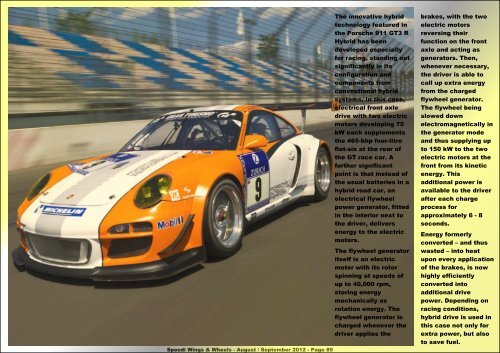Speedi
Issue No: 3 - August / September 2012 - Speedi Wings & Wheels
Issue No: 3 - August / September 2012 - Speedi Wings & Wheels
Create successful ePaper yourself
Turn your PDF publications into a flip-book with our unique Google optimized e-Paper software.
<strong>Speedi</strong> Wings & Wheels - August / September 2012 - Page 89<br />
The innovative hybrid<br />
technology featured in<br />
the Porsche 911 GT3 R<br />
Hybrid has been<br />
developed especially<br />
for racing, standing out<br />
significantly in its<br />
configuration and<br />
components from<br />
conventional hybrid<br />
systems. In this case,<br />
electrical front axle<br />
drive with two electric<br />
motors developing 75<br />
kW each supplements<br />
the 465-bhp four-litre<br />
flat-six at the rear of<br />
the GT race car. A<br />
further significant<br />
point is that instead of<br />
the usual batteries in a<br />
hybrid road car, an<br />
electrical flywheel<br />
power generator, fitted<br />
in the interior next to<br />
the driver, delivers<br />
energy to the electric<br />
motors.<br />
The flywheel generator<br />
itself is an electric<br />
motor with its rotor<br />
spinning at speeds of<br />
up to 40,000 rpm,<br />
storing energy<br />
mechanically as<br />
rotation energy. The<br />
flywheel generator is<br />
charged whenever the<br />
driver applies the<br />
brakes, with the two<br />
electric motors<br />
reversing their<br />
function on the front<br />
axle and acting as<br />
generators. Then,<br />
whenever necessary,<br />
the driver is able to<br />
call up extra energy<br />
from the charged<br />
flywheel generator.<br />
The flywheel being<br />
slowed down<br />
electromagnetically in<br />
the generator mode<br />
and thus supplying up<br />
to 150 kW to the two<br />
electric motors at the<br />
front from its kinetic<br />
energy. This<br />
additional power is<br />
available to the driver<br />
after each charge<br />
process for<br />
approximately 6 - 8<br />
seconds.<br />
Energy formerly<br />
converted – and thus<br />
wasted – into heat<br />
upon every application<br />
of the brakes, is now<br />
highly efficiently<br />
converted into<br />
additional drive<br />
power. Depending on<br />
racing conditions,<br />
hybrid drive is used in<br />
this case not only for<br />
extra power, but also<br />
to save fuel.





